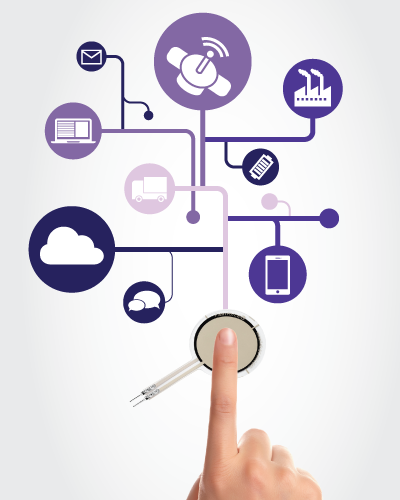How Can the Sense of Touch Enhance IoT Processes?

In a recent Machine Design article written by Bradford L Goldense, advancements in the Industrial Internet of Things (IIOT) and Internet of Things (IOT) concepts are likely to ramp up over the next decade. Goldense mentions that sensors of all types will be needed to generate the source data that drives the IoT's intelligence. The companies that are making the most progress in embedding sensing technology into their products today will be the likely leaders of what is bound to be a phenomenon that will change how the world operates.
IoT is loosely defined as smart devices and systems working together without human interaction. The components in an IoT process essentially need to be able to sense the world around them at all times. Some IoT concepts are loftier than others, but in the cases where changes in force play a role in making IoT processes function, embedding tactile force sensors into these systems can help bring these broad ideas to reality.
Tactile force sensors provide touchpoints for IoT connections
Tactile force sensors, such as FlexiForce™ sensors, are the ideal force sensing solution for embedding on account of their flexible designs, low power requirements and other features. Having the ability to capture force data within a paper-thin space can help give product developers more freedom to design products with sensor-enabled product architecture.
So, how can tactile force sensors play a role in making an IoT process go? Think of any repetitive tasks your end user performs that could be streamlined with real-time knowledge of force changes. For example, when a pack of butter is taken off of a shelf at a supermarket, the shelf experiences a change in force. Embedding the shelving unit with a tactile force sensor to capture real-time changes in force can help shopkeepers stay aware of product inventory without having to observe on the store floor. Taking this concept further down the IoT pipeline, after enough packs of butter have been taken off the shelves, an alert can be sent to a distribution center to schedule a new delivery to the supermarket.
Embedding products with tactile force sensors can also play a role in driving IoT processes that enhance medical treatment. For instance, a patient who has experienced an injury sees a physical therapist for a few sessions a week. However, in an IoT world, therapy doesn't have to stop when the patient leaves the physician's office. Embedding tactile force sensors into therapeutic equipment like crutches, wheel chairs, air cast walking boots or corrective shoes can capture valuable information on how the patient is using the equipment. This quantitative data can help physicians keep tabs on their patients at all times and develop a better path for their recovery.
There's no time to waste
With the IIoT and IoT eras rapidly approaching, now is the time to begin considering ways force sensors can help your products support these processes. Begin by thinking about how your end-user interfaces with your product. What repetitive implements or "touches" can be streamlined with force sensing technology? Do changes in force that occur within or outside of your product affect how it functions? What forces are your products currently not capturing?
Creating products with a sense of touch can provide incredible opportunities for IoT automation. Check out this video for inspiration:
Previous Post: |
